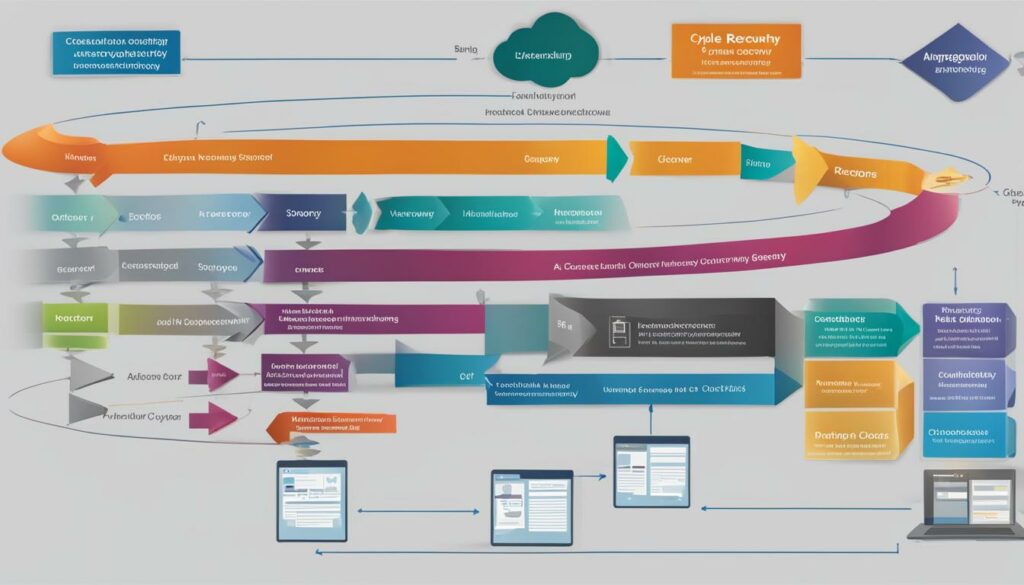Data lifecycle management (DLM) is a strategic approach to managing data throughout its lifecycle, from creation to destruction. It involves separating data into different phases and implementing policies to ensure its security and availability. DLM plays a crucial role in data recovery, as it enables organisations to have a well-defined plan in place to restore data in the event of a breach or system failure. This article will explore the various stages of the data lifecycle and their connection to data recovery.
Key Takeaways
- Data lifecycle management (DLM) is crucial for the security and availability of data.
- DLM involves separating data into different phases, from creation to destruction.
- Organisations can proactively prepare for data breaches or system failures through DLM.
- Data recovery relies on a well-defined plan and the implementation of DLM strategies.
- Data backup and storage are essential components of DLM for disaster recovery.
What is Data Lifecycle Management?
Data lifecycle management (DLM) is a strategic approach to managing data throughout its lifecycle, from creation to destruction. It involves separating data into different phases and implementing policies to ensure its security and availability. DLM plays a crucial role in data recovery, as it enables organizations to have a well-defined plan in place to restore data in the event of a breach or system failure.
At its core, DLM aims to provide structure and organization to a business’s data, ensuring data security and availability. By managing data from its entry point to its destruction, organizations can better protect their valuable information. The main goals of DLM are data protection and disaster recovery. By implementing a DLM strategy, organizations can prepare for the potential consequences of data breaches or system failures and reduce the impact on their brand’s reputation.
Data security is a key aspect of DLM. It involves implementing measures to ensure data integrity, confidentiality, and availability. Data must be stored securely and protected against unauthorized access or malicious attacks. Data integrity ensures that data remains accurate and reliable, regardless of where it is stored or how many copies are maintained. Data availability ensures that authorized users can access the data when and where they need it, without disruptions to their workflows.
Key Benefits of Data Lifecycle Management
Data lifecycle management offers several benefits to organizations. By maintaining data quality throughout its lifecycle, DLM enables process improvement, increasing efficiency and driving strategic initiatives. Additionally, DLM helps control costs by implementing data backup, replication, and archiving solutions to reduce storage expenses. It improves data usability by ensuring consistent metadata tagging and enforceable governance policies, increasing accessibility and efficiency. Moreover, DLM helps organizations maintain compliance with data privacy laws and industry regulations, reducing the risk of fines and penalties.
Phases of Data Lifecycle Management
Data lifecycle management encompasses several essential phases that data goes through during its useful life. Each phase plays a crucial role in managing and securing data effectively. Let’s explore these phases in detail:
Data Creation
The data creation phase is where data is collected from various sources, including customer interactions, transactions, and operational activities. This data is then evaluated for its quality and relevance to ensure accurate decision-making. Organizations must establish data governance policies and data entry standards to maintain data integrity during this phase.
Data Storage
Once data is created, it needs to be securely stored. In the data storage phase, measures such as data encryption and redundancy are implemented to protect data from unauthorized access and system failures. Organizations must also determine the appropriate storage solutions based on factors like data size, speed of access required, and security level. This ensures that data remains accessible and secure throughout its useful life.
Data Sharing and Usage
Data becomes valuable when it is shared and used by authorized individuals within an organization. During this phase, data is made available to authorized users for analysis, decision-making, and collaboration. Organizations must implement access controls and data usage policies to ensure that data is used in accordance with privacy regulations and business requirements. By promoting efficient data sharing and usage, organizations can leverage the full potential of their data assets.
Data Archival
As data ages and becomes less frequently accessed, organizations must consider archiving it. The archival phase involves storing data that is no longer needed for everyday operations but may still be required for potential litigation, compliance, or investigation purposes. Archiving data helps organizations maintain regulatory compliance while optimizing their storage resources. It is crucial to define clear retention policies and establish secure archival processes to ensure the long-term preservation and accessibility of archived data.
Data Deletion
At the end of its lifecycle, data needs to be securely and permanently deleted. The data deletion phase involves purging data from records and ensuring it cannot be recovered. Proper data deletion processes are essential to comply with privacy regulations and protect sensitive information from unauthorized access. Organizations must implement data erasure techniques and document the deletion activities to demonstrate compliance with data privacy laws.
| Phase | Description |
|---|---|
| Data Creation | Data is collected from various sources and evaluated for quality and relevance. |
| Data Storage | Data is securely stored, implementing encryption and redundancy measures. |
| Data Sharing and Usage | Data becomes available to authorized users for analysis, decision-making, and collaboration. |
| Data Archival | Data that is no longer needed for everyday operations is securely stored for legal or compliance purposes. |
| Data Deletion | Data is securely and permanently deleted to comply with privacy regulations and protect sensitive information. |
Benefits of Data Lifecycle Management
Data lifecycle management (DLM) offers numerous benefits to organizations looking to enhance their data management processes. By implementing DLM strategies, businesses can improve their overall operations and drive growth. Here are some key benefits of incorporating data lifecycle management:
1. Process Improvement
DLM enables organizations to streamline their data management processes, resulting in improved efficiency and productivity. With a well-defined data lifecycle, businesses can establish standardized procedures for data creation, storage, sharing, archival, and deletion. By optimizing these processes, organizations can reduce manual errors, eliminate unnecessary redundancies, and enhance overall data quality. This leads to better decision-making, increased operational effectiveness, and improved customer experiences.
2. Cost Control
Implementing data lifecycle management allows organizations to control their data-related costs efficiently. By classifying data based on its lifecycle stage, businesses can allocate storage resources more effectively. DLM enables the identification of data that requires immediate access and data that can be stored in cost-effective storage solutions. This helps reduce unnecessary expenditures on high-cost storage solutions for data that is no longer frequently used. Additionally, adopting data backup, replication, and archiving strategies as part of DLM can minimize the risk of data loss and expensive recovery processes.
3. Data Usability
DLM ensures that data remains usable and accessible throughout its lifecycle. By implementing consistent metadata tagging and enforceable governance policies, organizations can maintain data integrity and enhance data discoverability. Metadata tagging allows for easy categorization and searchability of data, enabling authorized users to find relevant information quickly. With DLM, businesses can also establish data governance policies and permissions, ensuring that data is accessible to the right individuals while maintaining data security and compliance.
4. Compliance and Governance
Data lifecycle management helps organizations maintain compliance with data privacy laws and industry regulations. By defining policies and procedures to govern data handling, organizations can ensure adherence to relevant data protection regulations. DLM also facilitates the enforcement of data retention policies, ensuring that data is retained for the required period and disposed of appropriately. Compliance with data governance frameworks not only reduces the risk of non-compliance fines and penalties but also helps build trust with customers and stakeholders.

In conclusion, data lifecycle management offers significant benefits to organizations seeking to optimize their data management processes. By focusing on process improvement, cost control, data usability, and compliance and governance, businesses can enhance their overall data management efficiency and ensure the security and availability of their valuable data.
Data Lifecycle Management and IBM
Data lifecycle management is a critical aspect of effective data management, ensuring that data is properly managed and secured throughout its lifecycle. In this context, IBM Cloud Pak for Data offers comprehensive solutions to help organizations streamline their data management processes and maximize data security.
IBM Cloud Pak for Data leverages microservices and advanced data and AI capabilities to facilitate seamless data integration and provide a holistic view of business performance. With its competitive security frameworks, IBM ensures that data management teams can trust the security and compliance of their data. The platform also offers reliable data backup and recovery solutions, minimizing the impact of system failures or data breaches.
IBM Cloud Pak for Data enables organizations to effectively manage their data throughout its lifecycle, ensuring data integrity, availability, and security. With its advanced features and robust security measures, IBM is a trusted partner for organizations seeking a comprehensive data lifecycle management solution.
Key Benefits of IBM Cloud Pak for Data
- Streamlined Data Management: IBM Cloud Pak for Data provides a centralized platform for managing data across its lifecycle, simplifying data governance and ensuring consistent data quality.
- Enhanced Data Security: The platform’s advanced security features, including encryption and access controls, protect data from unauthorized access or breaches, ensuring data confidentiality and compliance.
- Data Backup and Recovery: IBM Cloud Pak for Data offers reliable data backup and recovery solutions, ensuring data availability and minimizing downtime in the event of system failures or data loss.
- Scalability and Flexibility: The platform is designed to scale seamlessly to accommodate growing data volumes and diverse data sources, providing organizations with the flexibility to adapt to changing business needs.
With IBM Cloud Pak for Data, organizations can effectively manage their data throughout its lifecycle, ensuring data security, availability, and compliance. By leveraging the platform’s comprehensive features and advanced security measures, organizations can streamline their data management processes and minimize the risks associated with data breaches or system failures.

What is Data Security?
Data security refers to the measures and practices implemented to protect data from unauthorized access, corruption, or loss. It is a critical aspect of data management, ensuring the confidentiality, integrity, and availability of data throughout its lifecycle.
Data integrity ensures that data remains accurate and reliable, regardless of where it is stored or how many copies are maintained. It involves implementing mechanisms to prevent data tampering, such as checksums or digital signatures.
Data availability ensures that authorized users can access the data when and where they need it, without disruptions to their workflows. This involves implementing redundancy and backup solutions to ensure data is accessible even in the event of system failures or disasters.
“Data security is not just about protecting data from external threats, but also about ensuring the reliability and accessibility of data for authorized users.” – Data Security Expert
Implementing robust data security measures is essential to safeguard sensitive information, comply with data protection regulations, and maintain customer trust. Organizations must establish policies and procedures to protect data throughout its lifecycle, including encryption, access controls, secure storage, regular data backups, and employee training on data security best practices.
| Data Security Measures | Description |
|---|---|
| Encryption | Converting data into an unreadable format to protect it from unauthorized access. |
| Access Controls | Implementing authentication and authorization mechanisms to restrict access to data based on user roles and permissions. |
| Secure Storage | Storing data in secure environments, such as encrypted databases or cloud storage with strong access controls. |
| Data Backups | Regularly creating copies of data to ensure its availability in case of data loss or corruption. |
| Employee Training | Providing education and awareness programs to employees to help them understand their role in maintaining data security. |

Conclusion
Data lifecycle management plays a crucial role in the effective management and protection of data throughout its lifecycle. By implementing a comprehensive data lifecycle management strategy, organizations can ensure that their data is properly managed, secured, and recoverable.
With the increasing risks of data breaches and system failures, prioritizing data lifecycle management is essential. By proactively preparing for potential data breaches or system failures, organizations can minimize the impact on their operations and protect their valuable data.
IBM Cloud Pak for Data offers solutions that enable organizations to streamline their data management processes and maximize data security. With advanced data and AI capabilities, organizations can integrate their data and gain a holistic view of their business performance. Additionally, IBM provides data recovery services to ensure data availability and minimize disruptions caused by system failures or data breaches.
By prioritizing data lifecycle management and leveraging solutions like IBM Cloud Pak for Data, organizations can effectively manage their data, protect it from threats, and ensure its recoverability. Investing in data lifecycle management is investing in the long-term success and security of your organization.
FAQ
What is data lifecycle management (DLM)?
Data lifecycle management is a strategic approach to managing data from creation to destruction, ensuring its security and availability throughout its lifecycle.
Why is data lifecycle management important for data recovery?
Implementing a data lifecycle management strategy allows organizations to have a well-defined plan in place to restore data in the event of a breach or system failure.
What are the phases of data lifecycle management?
The phases of data lifecycle management include data creation, storage, sharing and usage, archival, and deletion.
What benefits does data lifecycle management offer to organizations?
Data lifecycle management improves process improvement, controls costs, enhances data usability, and helps maintain compliance with data privacy laws and industry regulations.
How does IBM Cloud Pak for Data support data lifecycle management?
IBM Cloud Pak for Data provides business solutions that enable organizations to effectively manage data throughout its lifecycle, including data integration, data backup, and recovery solutions.
What is data security?
Data security involves implementing measures to ensure data integrity, confidentiality, and availability, protecting data against unauthorized access or malicious attacks.
What is the connection between data lifecycles and recovery?
Data lifecycle management plays a crucial role in data recovery, as organizations can proactively prepare for potential data breaches or system failures.
